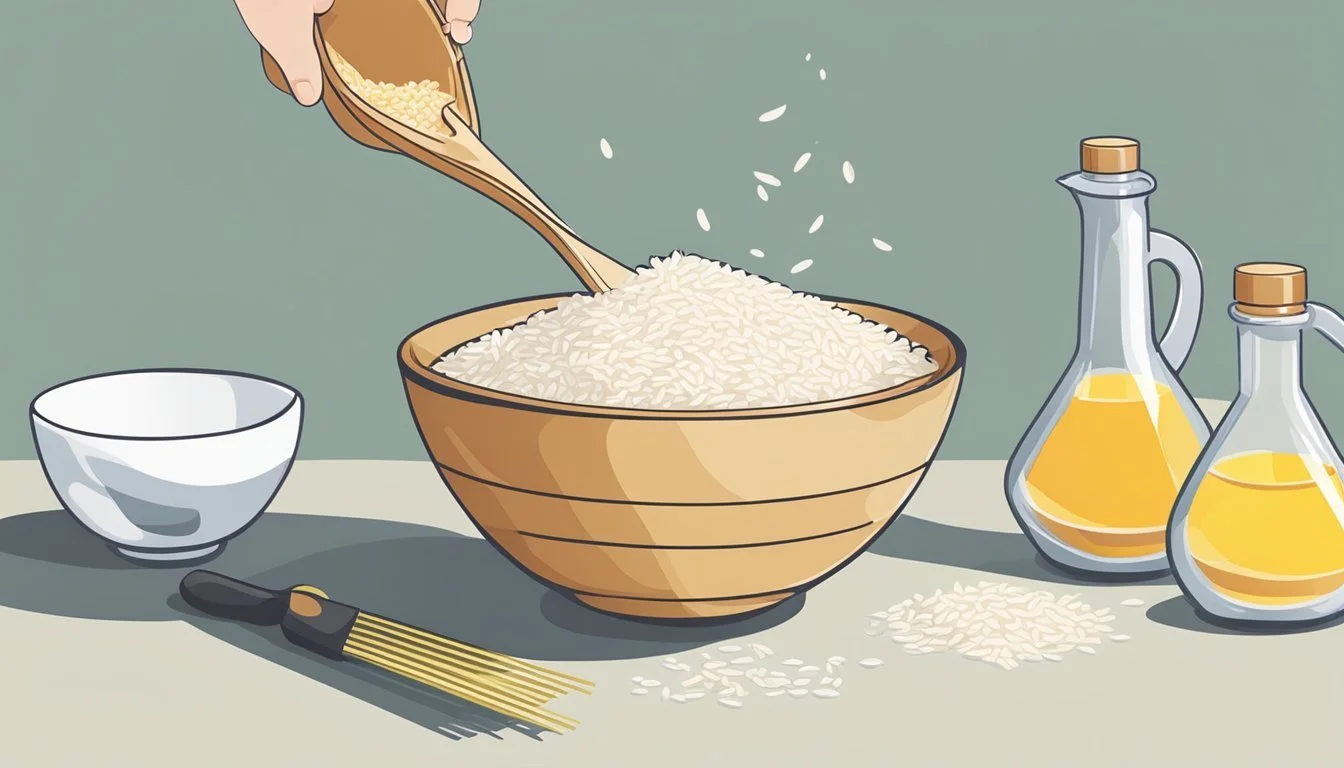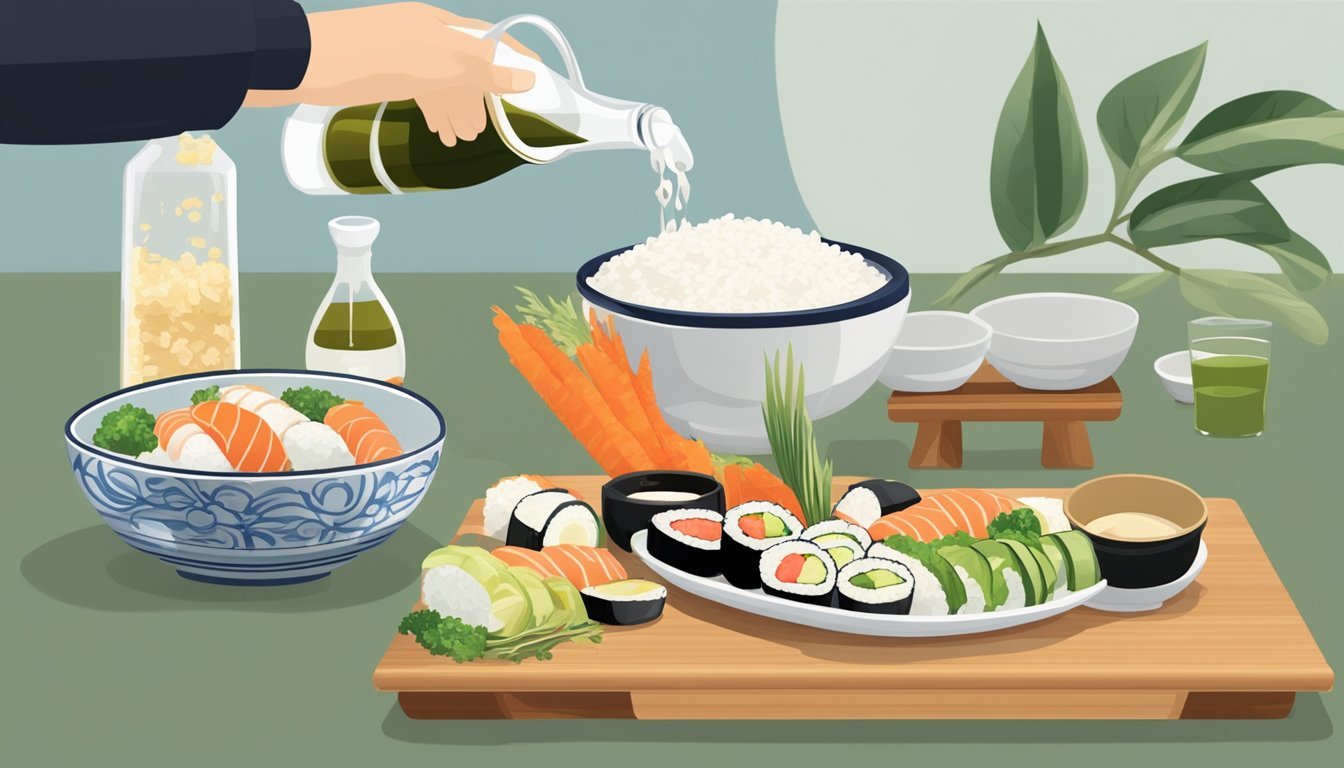How to Substitute Rice Vinegar for White Vinegar
An Easy Swap Guide
Rice vinegar and white vinegar are staple ingredients in many cuisines, valued for their ability to enhance flavors and add acidity to dishes. While both are varieties of vinegar, they bring different taste profiles and levels of acidity to recipes. Rice vinegar, derived from fermented rice, has a mild, slightly sweet flavor compared to the more robust and sharp taste of white vinegar that comes from grain-based alcohol.
When a recipe calls for rice vinegar and none is on hand, white vinegar can be used as a substitute. However, due to its stronger acidity and less delicate flavor, it is advisable to modify the white vinegar to better mimic the qualities of rice vinegar. This can usually be achieved by diluting white vinegar with water and/or adding a small amount of sugar to balance the acidity, ensuring the flavors in the dish remain as intended.
Understanding how these two vinegars differ is essential when considering a substitution, as it can impact the final outcome of recipes. In contexts where subtlety and a hint of sweetness are important, such as in certain dressings and Asian dishes, adjustments may need to be made to preserve the integrity of the dish's flavor palette. With careful calibration, white vinegar can effectively replace rice vinegar, maintaining the desired taste and harmony of ingredients.
Understanding Vinegar Fundamentals
In approaching the substitution of rice vinegar for white vinegar, understanding the basics of vinegar is essential. This includes the various types available, their distinct acidity and flavor profiles, and their common culinary applications.
Types of Vinegar
Vinegar is a versatile ingredient produced through the process of fermentation of natural sugars into alcohol and subsequent fermentation into acetic acid. The source ingredients largely determine its flavor, sweetness, acidity, and color. Key varieties include:
White Vinegar: Made from grain-based ethanol or acetic acid diluted with water, known for its high acidity and neutral flavor.
Rice Vinegar: Typically fermented from rice wine, offering a milder acidity and a subtle sweetness.
Other types such as apple cider, balsamic, and wine vinegars also contribute diverse flavors to the culinary palette.
Acidity and Flavor Profiles
Each type of vinegar possesses a unique acidity level and flavor profile reflective of its fermentation source and process. For instance:
White Vinegar: High acidity at 5-7%, with a clean and sharp flavor.
Rice Vinegar: Lends a lighter acidity, ranging from 4-5%, with a mild and slightly sweet taste.
Understanding these characteristics helps in making appropriate substitutions that maintain the integrity of a dish's flavor balance.
Common Uses of Vinegar
The use of vinegar extends across various culinary techniques, from pickling and preserving to making marinades and dressings. Here's how different vinegars fit into cooking:
White Vinegar: Its strong acidity makes it ideal for pickling, household cleaning, and as a brightening agent in marinades.
Rice Vinegar: Commonly used in Asian cuisine, its sweetness and subtle flavor are excellent for sushi rice, salad dressings, and slaws.
By considering these factors, one can confidently substitute vinegars while respecting the intended taste and quality of the recipe.
Rice Vinegar: Characteristics and Uses
Rice vinegar, with its distinct sweetness and mild tartness, plays a vital role in Asian cuisine, enhancing the flavors from sushi rice to pickles.
The Unique Qualities of Rice Vinegar
Rice vinegar is made from fermented rice and is known for its relatively low acidity and subtle sweetness compared to other vinegars. Its delicate flavor profile is attributed to the fermentation process, wherein the sugars in rice are transformed to alcohol, and then to acetic acid. Rice wine vinegar, often used interchangeably with rice vinegar, adds a touch of zest without overpowering dishes.
Sweetness: Less intense than western vinegars.
Acidity Level: Milder, making it more versatile.
Culinary Applications of Rice Vinegar
In the realm of Asian recipes, rice vinegar is indispensable. It imparts a delicate tang to sushi rice, essential for achieving the authentic taste of sushi. Beyond sushi, it is utilized in a variety of dishes to brighten flavors:
Asian Cuisine: A staple for dressings, marinades, and sauces.
Pickles: Adds a subtle tang to pickled vegetables.
Whether it's bringing harmony to a stir-fry or contributing a note of sophistication to salad dressings, rice vinegar’s versatility is celebrated across numerous Asian culinary applications.
White Vinegar: Properties and Culinary Roles
White vinegar, commonly known as distilled white vinegar, is a clear solution typically consisting of about 4-7% acetic acid and 93-96% water. It stands out for its clean, sharp flavor and its versatility in various culinary and household applications.
The Versatility of White Vinegar
White vinegar serves as a staple in many kitchens due to its multifaceted uses. One can find it employed in numerous processes from pickling to enhancing the flavors of salad dressings. Its high acidity level is effective for preservation, as it inhibits the growth of bacteria, making it ideal for pickling a variety of vegetables.
Salad Dressings: White vinegar adds a tangy punch to vinaigrettes and dressings.
Pickling: A 1:1 water to vinegar ratio forms the foundation of a basic pickling brine.
Cooking with White Vinegar
In the culinary world, distilled white vinegar is valued for its clear, pungent flavor that does not overpower dishes. Chefs often use it to add acidity to salad dressings, marinades, and sauces. White vinegar's neutral profile also makes it a common choice for cleaning purposes in the kitchen, where its astringent properties can help sanitize surfaces and remove odors.
Neutral Flavor Enhancer: Adds a crisp, acidic note without altering the color of foods.
Cleaning Agent: Used to clean cookware and appliances, it leaves no residue and helps dissolve mineral deposits.
The Art of Substitution
Understanding how to substitute rice vinegar for white vinegar is crucial when the recipe demands a certain flavor profile and acidity. This section will guide readers through when it is appropriate to make a substitution, the taste considerations to keep in mind, and the exact ratios needed to successfully replicate the intended culinary experience.
When to Substitute Vinegar
In culinary practices, one might need to substitute vinegar primarily due to its unavailability or to tailor a recipe for specific dietary preferences. Rice vinegar is often favored for its sweet and mild taste, which is less overpowering than many other vinegars. It is a staple in Asian cuisine, used in dressings, marinades, and sushi rice. When rice vinegar is not on hand, white vinegar, which is more acidic and has a sharper flavor, can be modified and used as a substitute.
Taste Considerations for Substituting Vinegar
When substituting white vinegar for rice vinegar, one should consider the flavor differences. Rice vinegar is sweet and subtle, whereas white vinegar is more intense and sharp. To mimic the gentle tang and sweetness of rice vinegar:
Decrease the strength of white vinegar by adding water.
Sweeten the mixture with sugar to achieve a closer match to rice vinegar's natural sweetness.
Substitution Ratios and Measurements
Getting the substitution right involves precise ratios and measurements. Here's a simple guideline to follow:
Substitute Ratio Additional Ingredient Amount per tablespoon of vinegar White Vinegar 1:1 Water 1 tablespoon Sugar ¼ teaspoon
These measures ensure that the flavoring closely resembles that of rice vinegar.
Using white vinegar as a substitute for rice vinegar should be a carefully measured decision, keeping in mind the recipe's flavor balance and the resulting taste after substitution. With these guidelines, one can confidently use white vinegar as a substitute while preserving the integrity of the dish.
Alternatives to Rice Vinegar
When seeking out a substitute for rice vinegar, one can choose from a variety of vinegars and acidic liquids that can replicate the tang and flavor profile to varying degrees.
Using White Vinegar as a Substitute
White vinegar is the most straightforward substitute for rice vinegar. It has a stronger acidity and a more pronounced flavor, which should be considered when using it as a replacement. For every tablespoon of rice vinegar, one can use the same amount of white vinegar, potentially diluted with water to match the milder taste of rice vinegar. To better mimic the sweetness of rice vinegar, adding a small amount of sugar is advisable.
Other Vinegar Substitutes
Several other vinegar types can serve as potential substitutes for rice vinegar, each with unique properties:
Apple Cider Vinegar: Offers a fruity note and is less sharp than white vinegar. Use a 1:1 ratio when substituting.
White Wine Vinegar: A milder vinegar with a slight sweetness, suitable in a 1:1 replacement ratio.
Champagne Vinegar: Delivers a delicate flavor that works well in dressings and marinades. It's interchangeable in equal parts with rice vinegar.
Balsamic Vinegar: A sweeter and more aromatic vinegar, it should be used sparingly due to its bold flavor and color.
Malt Vinegar: Its stronger and nuttier taste can compete with other ingredients, therefore it's less commonly used as a substitute for rice vinegar.
Non-Vinegar Alternatives
For those seeking an alternative to vinegar altogether, citrus juices offer a viable option:
Lemon Juice: Brings brightness and acidity to dishes; it is more tart than rice vinegar, so one might need to balance it with a bit of sweetness.
Lime Juice: Similar to lemon juice in its functionality, it offers a distinct citrus flavor, ideal for Thai dishes and can be used in a 1:1 ratio.
Recipes and Cooking Techniques
When substituting rice vinegar for white vinegar in recipes, it is crucial to understand the impact on taste and adjust the recipe accordingly to maintain flavor balance. Vinegar can be a key ingredient in dressings, sauces, marinades, and certain cooking techniques, particularly in Asian cuisine.
Adjusting Recipes for Vinegar Substitutes
Substituting white vinegar for rice vinegar requires precise adjustments due to the former's stronger acidity and less sweetness. Consider the following modifications:
Sauces and Dressings: For each tablespoon of rice vinegar, use one tablespoon of white vinegar with a quarter teaspoon of sugar to replicate the mild sweetness of rice vinegar. Dissolve the sugar into the vinegar before adding to the recipe.
Marinades and Glazes: When rice vinegar is not available, white vinegar can be used in a 1:1 ratio. However, because of its higher acidity, dilute the white vinegar by adding one tablespoon of water to every tablespoon of vinegar to soften the tanginess.
Cooking with Vinegar Substitutes in Asian Cuisine
Vinegar plays a pivotal role in the flavor profile of various Asian dishes. Here are guidelines for cooking with vinegar substitutes:
Vinaigrettes: Replace rice vinegar with white vinegar mixed with a small amount of sugar to maintain the intended balance of sweetness and tanginess.
Stir-fries: When making stir-fries, white vinegar can serve as a substitute for rice vinegar, but the recipe may need to be adjusted with a splash more of a sweetening agent to counteract the sharpness.
Asian Dishes: For sushi rice, dressings, or delicate sauces, it's essential to substitute cautiously. The substitution should be made in equal measure but with the addition of sugar to achieve a flavor resembling that of rice vinegar.
By following these guidelines, one can seamlessly substitute white vinegar for rice vinegar without compromising the original taste and quality of a dish.
Additional Tips and Tricks
When substituting rice vinegar for white vinegar, it's important to understand how to maintain the desired flavor profile of the dish. Both the sweetness and acidity can be adjusted to achieve the ideal balance when using alternative vinegar types.
Enhancing Flavors with Substitutes
To best mimic the subtle flavor of rice vinegar, one may need to enhance the characteristics of the substitute. If using white wine vinegar, which has a comparable delicacy to rice vinegar, they can use it directly in equal parts. For a sharper, more robust substitute like plain white vinegar, it is advisable to dilute it with water to reduce intensity. Adding sugar can further refine the flavor, softening the harshness and bringing it closer to the gentle sweetness associated with rice vinegar.
Here's a simple guideline:
Plain white vinegar: Mix with an equal amount of water. For each tablespoon of white vinegar, add up to 1/4 teaspoon of sugar to match the sweetness level of rice vinegar.
White wine vinegar and Champagne vinegar: No dilution needed. Use equal parts as a substitute. Adjust sugar to taste if a sweeter profile is desired.
Balancing Sweetness and Acidity
The ideal balance between sweetness and acidity is crucial in replicating the taste of rice vinegar. One should consider the dish's flavor profile as a whole when adding sugar. If the recipe already contains sweet elements, they might need less added sugar when substituting vinegar. Conversely, if the dish is more savory or acidic, a touch more sugar might be necessary to achieve the correct balance.
The following is a helpful balance reference:
Dentifying acidity levels: Taste and adjust. If it's too tart, incrementally add sugar. If too sweet, add small additional amounts of the substitute vinegar.
Achieving desired sweetness: Start with the recommended addition of sugar and adjust according to the dish. Cooks should remember that heat can help dissolve sugar more readily, resulting in a well-integrated flavor.
By considering both the acidity and sweetness, cooks can effectively use alternative vinegars without compromising the integrity of the original recipe.
Health Considerations and Dietary Preferences
When substituting rice vinegar for white vinegar, one must consider the health benefits of various vinegars and the needs of special diets. The choice can impact both the nutritional content of the dish and its suitability for different dietary restrictions.
Health Benefits of Different Vinegars
Rice Vinegar: Typically milder in flavor, it contains trace amounts of amino acids and is often used in Asian cuisine. Its subtle sweetness can enhance the flavors of vegetables and other ingredients without overpowering them.
White Vinegar: More acidic and with a sharper flavor, white vinegar can act as a preservative in pickling. It is low in calories and contains no fat, making it a suitable choice for those monitoring their caloric intake during cooking.
Vinegar Substitutes for Special Diets
Gluten-free Diets: Some vinegars, especially those made from grains, may contain gluten. Rice vinegar is generally gluten-free, making it a safe choice for those with gluten sensitivities or celiac disease.
Low-sodium Diets: Those following a low-sodium diet should note that some vinegar substitutes, like soy sauce, are high in sodium. Reading labels carefully to choose low-sodium options is key.
Vegan Diets: White vinegar is typically vegan, as it is made from fermenting distilled alcohol. Rice vinegar, also vegan, is a suitable option for those following plant-based diets.
Storage and Shelf Life
When it comes to vinegar, understanding how to store it properly and knowing its shelf life are crucial for maintaining quality, especially when substituting rice vinegar for white vinegar. Proper storage ensures the vinegar retains its flavor profile and acidity, which is essential in dishes like pickled vegetables, (What wine goes well with pickled vegetables?) coleslaw, and salad dressings.
Preserving Vinegar
Rice Vinegar:
Shelf Life: Typically lasts over 5 years unopened; quality is best when used within this time frame.
Storage Conditions:
Find a cool, dark place such as a pantry or a kitchen cupboard.
Keep it away from direct sunlight and sources of heat to prevent deterioration.
White Vinegar:
Due to its acidic nature, white vinegar has a practically indefinite shelf life.
Similar to rice vinegar, it should be stored in a cool, dark environment.
Storing Substitutes
For substitute vinegars such as white wine vinegar:
A 1:1 ratio is advised when replacing rice vinegar with white wine vinegar.
Additional Ingredient: Add a quarter teaspoon of sugar per tablespoon of substitute to mimic the mild sweetness of rice vinegar.
Storing these substitutes:
White Wine Vinegar: Seal tightly and store it in a similar fashion to rice vinegar.
When substituting in recipes for pickled vegetables, coleslaw, or salad dressings, one must remember that storage and shelf life affect the final taste of your dishes. Using well-stored vinegars ensures that substitutes perform similarly to the original ingredient.
Conclusion
In the culinary world, flexibility is key, and knowing how to substitute ingredients can save a dish. When seeking an alternative for rice vinegar, white vinegar is a readily available option that can be used with minor adjustments.
Substitution Proportions:
Equal parts of white vinegar can replace rice vinegar (1:1 ratio).
To Adjust Taste:
Add a quarter teaspoon of sugar to each tablespoon of white vinegar to mimic the sweetness of rice vinegar.
Additional Tips:
For dressings or marinades, consider diluting white vinegar with water to soften its strength.
Homemade rice vinegar can be created by combining white vinegar with water and a touch of sugar to taste.
A gentle heating of the mixture may be necessary to fully dissolve the sugar.
Remember, taste and flavor balance are paramount. Chefs should rely on their palate and make adjustments accordingly for the best results.








